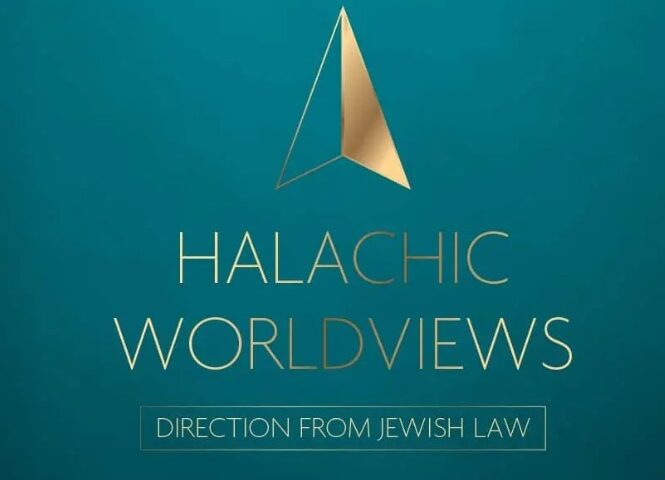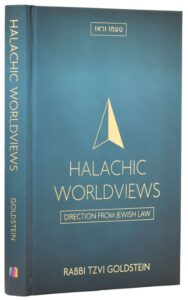REVIEW: Halachic Worldviews

 Tzvi Goldstein, Halachic Worldviews: Direction from Jewish Law (Mosaica Press), 285 pp.
Tzvi Goldstein, Halachic Worldviews: Direction from Jewish Law (Mosaica Press), 285 pp.
The distinction between halakha and aggada is so axiomatic as to seem structurally built into Jewish discourse. Halakha is binding; it regulates behaviors and teaches what is required or prohibited. Aggada is informational; it teaches the philosophical beliefs of Judaism and aspirational ethical ideals. These different literary modes are not opaque, when reading the Talmud they are obvious. If a student encounters a technical, legal discussion, he or she knows it is a halakhic section; if the passage includes stories or Biblical exegesis, it is aggadic.
For most Jewish thinkers the importance of this division is not only in categorizing Talmudic passages, but it enables their very system of thought. Halakha is the organizing principle of Judaism, but if all we had was halakha, so the thinking goes, Jewish philosophy would be sterile and dry. The freeing of Jewish thought and philosophy from the rigors and technicalities of halakhic details is enlivening. It allows Kabbalists the freedom to envision Judaism as a soaring mystical system, without encroaching on halakha, and it gives philosophers license to creatively toy with Jewish concepts, without dethroning halakhic practice.
The neat division of Jewish law versus philosophy has its obvious merits, but it also creates problems. First is the division itself. A well-thought-out system should create harmony between its various components. The sharp demarcation between Jewish ritual and philosophy poses a problem in this regard. Second is the problem of authority. The essence of Judaism is the halakha, and the legal sections of the Talmud are the most binding and authoritative texts for traditional Jews. If Jewish thought arises from a different source, it should by definition possess less authority. As such, Jewish philosophy is always of a secondary standing in Judaism.
One towering Torah figure proposed a daring alternative to this entrenched system. R. Joseph B. Soloveitchik, concluding his philosophical essay Halakhic Mind, proclaimed “Out of the sources of Halakhah, a new world view awaits formulation.” In this one sentence the Rav seemed to collapse the entire distinction between halakha and Jewish thought. Jewish philosophy derived straight out of the halakha! In the Rav’s thinking there is powerful unity coursing through Judaism, the rituals and ideas of Judaism derive from the same source. Of course, this is a welcome development, but it raised a new, rather obvious problem: from where in halakha does Jewish thought derive? What specific examples was the Rav referring to?
In many ways this project proved elusive for Modern Orthodoxy. If Jewish philosophy could be rooted in halakha, it would provide a far more stable basis for the entire system, not to mention the grand unity that would be achieved by combining halakha and philosophy together. R. Tzvi Goldstein’s new work, Halachic Worldviews, bravely attempts to fill this void. Taking his cues from the Rav, as well as an earlier Torah giant, R. Samson Raphael Hirsch, Goldstein bridges the worlds of halakha and Jewish thought. In sixteen chapters, each of which highlights a different halakhic topic and shows its relevance to religious ideas, Goldstein points to numerous instances of overlap between halakha and Jewish theology. Goldstein’s contribution is one of the few that I know of that attempts to systematically carry out the Rav’s approach.
This is a helpful book both in terms of filling in the Rav’s vision, as well as more broadly illustrating the overlap between spirituality and the minutia of halakha. As the author presents from his own experiences, and this will align with many people’s experiences, one of the great problems traditional Judaism faces is that halakhic details often seem detached from grand religious meaning. Goldstein’s examples all undermine this critique, showing examples where halakha does relate to important and central religious dilemmas. A significant example is chapter 7, entitled “Beis Hamikdash in Your Backyard,” where he surveys parallels in the halakhot of Sukka with the Mikdash, an insightful discussion which provides new meaning to dwelling in the Sukka. The individual chapters are genuine and engaging and present the information clearly, making this an enjoyable and spiritually uplifting read.
But Goldstein’s work is not only a contribution to halakhic thought in general, it is specifically inspired and helps fill out the Rav’s vision and methodology. Chapter 1, “Milah and Mission: Understanding Bris Milah,” is a near-perfect application of the Rav’s methodology. Beginning with a discussion of the connection between modern day circumcision and the commandment given to Avraham, the presentation then digresses to the technicalities of halakha in two unusual cases: women’s obligation in regard to this commandment, and the mila of converts. As the presentation wraps up, the disparate threads all tie together, with the point being that
Hashem assigned Avraham the monumental task of introducing Him to the world. That would not necessarily entail conversion; the ultimate goal was not for everyone to eventually join the Jewish nation, but to be inspired to see God as the Creator and Master of the world. Avraham, and B’nei Yisrael after him, were meant to help the nations of the world develop spiritually, much like a father helps his children develop physically (40-41).
The discussion weaves smoothly from complex halakhic points to fundamental issues regarding Jewish identity and purpose.
By inference, Goldstein clarifies an important point, that when R. Soloveitchik refers to “halakha,” he does not mean practical halakha or the surface reading of halakhic texts. It is a pointed reference to lomdus, the special method of conceptual analysis which he inherited from his grandfather, R. Hayyim of Brisk. The Rav is not suggesting that simply reading through halakhic texts offers a philosophical worldview, he means that by interpreting them properly one can glean philosophical insights and uncover philosophical sources. This means that applying the Rav’s vision involves a two-pronged method: first, analyzing the lomdus underpinning the halakha and then applying this conceptual analysis to the philosophical problem at hand. It is this which makes R. Soloveitchik’s method so challenging. One needs to have a thorough-going feel for both the subtleties of halakhic analysis and philosophical nuances to do it properly.
Goldstein is to be commended for taking up this complex mantle. In his discussions, the author continuously mines for deeper meaning of the halakha, which leads to some fascinating yeshiva-style lomdus. In chapter 11, when discussing pe’ah, the corners of the field the farmer leaves for the poor, he explores an intriguing debate over whether the pe’ah is given to the poor or merely abandoned for them to take. In chapter 15, Goldstein discusses the convoluted halakha that if a slave escapes to the Land of Israel he must be freed, explaining the topic’s mechanics in exceedingly logical terms.
Some of the chapters pointedly develop connections between lomdus and philosophy. Chapter 12 develops a compelling interpretation of a debate between Rambam and Tur in the laws of hashavat aveda (returning lost objects), with the philosophical question of the basis for private ownership. Chapter 13 connects a fascinating halakhic debate in contractual law: whether a hired employee can renege on a contractual agreement because they are first and foremost “servants of God,” with the issue of our relationship to the Almighty. At times the connections being drawn are so compelling that the reader, having been given the background of the lomdus, can intuit the ideological point to come.
Perhaps the greatest accomplishment of the book is the list of halakhic topics that Goldstein has compiled. The hardest part of a project such as this can be identifying the right examples> To accomplish this one must be widely learned and approach his studies with this methodology in mind in order to assemble the catalog. Goldstein’s list ranges from circumcision to blessings and prayers, to the laws of the synagogue, agricultural laws, returning lost objects, and slavery. A wide-ranging registry that illustrates the author’s long-standing dedication to this method of approaching halakhic texts.
In all of the above, the author has succeeded remarkably well in his stated goals. What is lacking is a more precise definition of the terms being used. R. Soloveitchik’s collapsing philosophy into halakha has occasioned decades of spirited discussion and debate as to what exactly he meant. What does the term “halakha” mean in this context? Is it limited to legal texts or perhaps refers more broadly to all canonical texts of Judaism? Similarly concerning “world view”: What type of philosophical thinking or ideas is the Rav referring to? Commentators have suggested various approaches to explain what he intended and what type of approach he himself utilized. Many of these ideas have proven useful and enlightening in interpreting the Rav’s method and writings.
To its detriment, this discussion is absent from Halachic Worldviews. The work would have benefited from more clarity as to the author’s methodology and how he understands R. Soloveitchik’s approach. Goldstein also invokes Rav Hirsch toward this goal, and further discussion of the overlap and subtle differences between these two great thinkers would have been fascinating and edifying. The author does provide a helpful list of 13 concepts that he considers the “values, ideals, and perspectives” of Judaism (22-23). But the precise meaning of what type of philosophy can be located in which type of halakhot is left unexplored. Such claims like, “While much has been done to further the Brisker derech of conceptual analysis, there is a dearth of maggidei shiur and published material that set out to develop a set of values and perspectives on life from the morashah kehillas Yaakov” (21), remain unclear, at least to this reader.
Halachic Worldviews is a worthwhile object of study and makes a serious contribution to the Rav’s methodological proposal. The author has not only produced meaningful lessons on the relationship between Jewish thought and in-depth halakhic analysis, but also modeled for his readers how to engage in such study. While R. Soloveitchik’s bold proposal for how to study halakha has until now largely been treated as theoretical—an intriguing suggestion, perhaps something that guided R. Soloveitchik’s own studies—it has generally not been seen as a model for the average student to utilize. Halachic Worldviews illustrates that far from an ivory tower methodology, “philosophy out of the sources of halakha” can provide genuine spirituality for us in our own studies. It is my hope that this represents a new trend and that others will eagerly respond to the call.
Elisha Friedman is the rabbi of Young Israel of Forest Hills.
